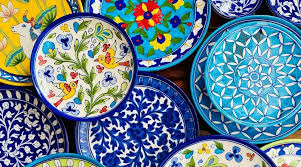SIGN UP FOR NEWSLETTER
Be the First to Know. Sign up to newsletter today

This is of Turko-Persian in origin. Firstly, the name ‘blue pottery’ comes from the eye-catching blue colour that is used. Cobalt is used for the blue dye. It has close similarity to the Islamic pottery. For instance, the blue is an imported technique from Mongolia and China . Further, it was introduced to India by the Turkish invaders.
Available at Jaipur:- Kripal Kumb(Jaipur), Neerja(Jaipur), Rajasthali(Jaipur)
Available at Delhi:- Dilli haat, Rajasthali, Rajasthan Emporioum
Unlike other forms of pottery, it doesn’t make use of any clay. Quartz stone powder, powdered glass, fuller’s earth, borax, gum and water are the main ingredients which form part of the making of blue pottery. The mould is fired at low temperatures.
The range of products is largely decorative, such as tiles, plates, vases, serving bowls, coasters, door knobs and boxes for trinkets. It is mostly decorated with bird and other animal motifs. Being fired at very low temperature makes them fragile.
This was introduced to Rajasthan via Kashmir. Sawai Ram Singh II who ruled Jaipur (1835-1880) contributed to the rich art and culture of Jaipur by establishing a school of art.
In later years, her Highness Gayatri Devi kept alive this traditional art form through the wide promotion of blue pottery.
Be the First to Know. Sign up to newsletter today
46 views